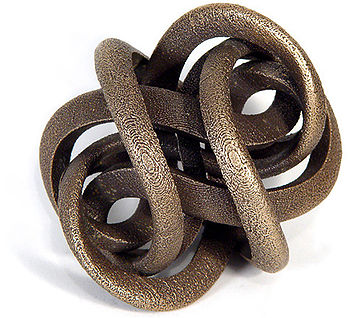Bathsheba: Difference between revisions
No edit summary |
No edit summary |
||
| (10 intermediate revisions by the same user not shown) | |||
| Line 1: | Line 1: | ||
[[File:clef.jpg|350px|right|link=]] | [[File:clef.jpg|350px|right|link=]] | ||
Bathsheba Grossman, the artist creator of this mathematical sculpture, says: ''This sculpture is a sign of order and harmony for every note and instrument, voice and music. It is a single ribbon that follows itself through space, and due to its unobstructed length it rings like a bell, low and long''; for us it is a sign of freedom. | |||
She kindly gaves us the permission to use it as the logo of the Traditional Tune Archive web site. | |||
Bathseba is an artist exploring the region between art and mathematics. | Bathseba is an artist exploring the region between art and mathematics. | ||
Her work is about life in three dimensions: working with symmetry and balance, getting from a zero point to infinity, and always finding beauty in geometry. | Her work is about life in three dimensions: working with symmetry and balance, getting from a zero point to infinity, and always finding beauty in geometry. | ||
Latest revision as of 11:56, 20 February 2025

Bathsheba Grossman, the artist creator of this mathematical sculpture, says: This sculpture is a sign of order and harmony for every note and instrument, voice and music. It is a single ribbon that follows itself through space, and due to its unobstructed length it rings like a bell, low and long; for us it is a sign of freedom.
She kindly gaves us the permission to use it as the logo of the Traditional Tune Archive web site.
Bathseba is an artist exploring the region between art and mathematics.
Her work is about life in three dimensions: working with symmetry and balance, getting from a zero point to infinity, and always finding beauty in geometry.
